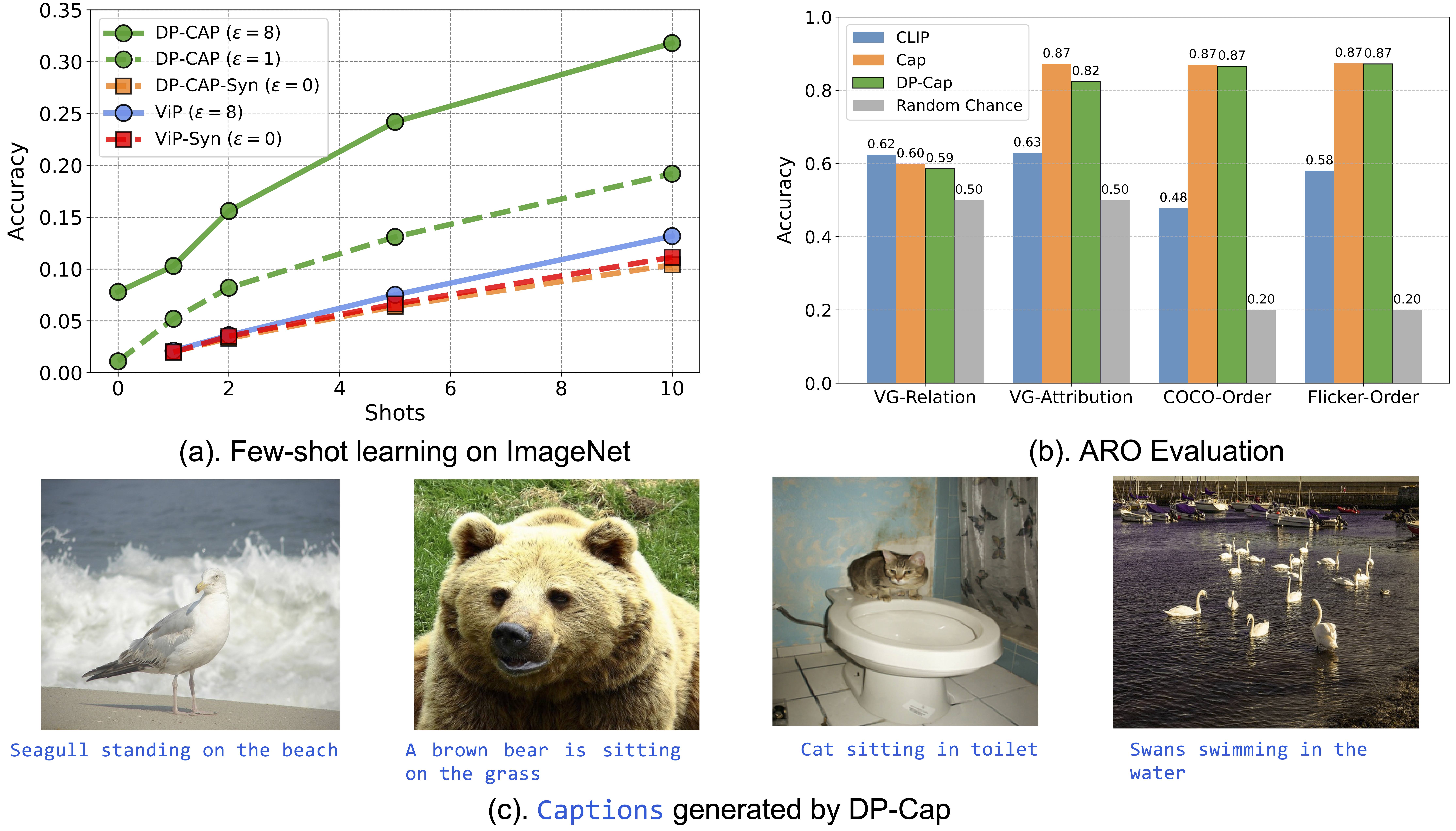Codebase for the ICML 2024 paper "Differentially Private Representation Learning via Image Captioning" (https://arxiv.org/abs/2403.02506)
TL;DR: A Differetentially Private Image Captionner trained on 233M image-text pairs, with
Tom Sander* (Ecole polytechnique, Meta FAIR), Yaodong Yu* (UC Berkeley, Meta FAIR), Maziar Sanjabi (Meta), Alain Durmus (Ecole polytechnique), Yi Ma (UC Berkeley), Kamalika Chaudhuri (Meta FAIR), Chuan Guo (Meta FAIR).
- Clone this respository and go to the
dpcapfolder, then clone and patch required submodules
git clone https://github.com/facebookresearch/dpcap.git
cd dpcap
git submodule update --init --recursive
cd private-transformers
git checkout 18ccc4eab7355e4ac96051a82434796f6aa4624b
git apply ../patch/private-transformers.patch
cd ../msn
git apply ../patch/msn.patch
cd ..
- Install requirements
conda create -n dpcap python==3.8
conda activate dpcap
pip install -r requirements.txt
cd private-transformers
pip install -e
WARNING: We are releasing the weights of models trained on the same dataset as Meta-CLIP, which differs from the DEDUP-LAION-233M dataset used in our paper.
Notably, this dataset contains 2 billion samples.
Currently, we are providing the weights for a DP-Cap base model with a privacy budget of
Performance
The vision encoder's performance is approximately equivalent to the model trained with
| Performance on ImageNet | Full Linear Prob | 10 shot | 5 shot | 1-shot |
|---|---|---|---|---|
| Percentage | 31.9% | 24.8% | 16.3% | 10.7% |
We have trained this model for 5000 steps, using
To load the base
import models_mae
import torch
import torchvision.transforms as transforms
from PIL import Image
from transformers import BertTokenizer
tokenizer = BertTokenizer.from_pretrained('bert-base-uncased')
device = torch.device("cuda")
model = models_mae.__dict__["mae_vit_base_patch16_autoregressive_nobias"](text_max_length=77) #40 can be changed by anything; you can aldo replace "base" by "large", "small" or "tiny"
model = model.cuda()
checkpoint = torch.load("./checkpoints/DP-Cap/base-eps7.pth", map_location='cpu')
msg = model.load_state_dict(checkpoint['model'], strict=False)
print(msg)image = Image.open("./images/00.png")
image_preprocess = transforms.Compose([
transforms.Resize((224, 224), interpolation=Image.BICUBIC),
transforms.Lambda(lambda x: x.convert("RGB")), # Convert RGBA to RGB
transforms.ToTensor(),
transforms.Normalize(mean=[0.485, 0.456, 0.406], std=[0.229, 0.224, 0.225])])
image_tensor = image_preprocess(image).cuda().unsqueeze(0)
##Representation (197*768)
x = model.linear_prob_forward(image_tensor)For zero-shot learning, we calculate the loss for each label and select the one with the smallest loss. Here's an example of how this process works when there are only five labels:
##Caption
from captioning import predicted_label, labels_lengths_with_BOS, input_ids_from_text
labels = {0:"zebra", 1:"dog", 2:"cat", 3:"building", 4:"city"}
text = ['this is a photo of a']
input_ids_ = input_ids_from_text(text, tokenizer)
_, dic, _ = labels_lengths_with_BOS(tokenizer,None, dic=labels)
key = predicted_label(model, input_ids_, image_tensor, dic, device)
print(labels[key])As outlined in the paper, the computational expense increases significantly with the number of labels. We propose a novel method to address this issue by implementing a tree search, as detailed in the captioning.py file.
Since DP-Cap was trained with captioning, it's possible to directly prompt the model to generate a caption from a given image.
##Caption
caption = model.forward_caption(image_tensor)
print(tokenizer.decode(caption))To pre-train DP-Cap with multi-node distributed training on your dataset of image-caption pairs, run the following on 16 nodes with 8 GPUs each:
python submitit_pretrain.py \
--job_dir ${JOB_DIR} \
--folder ${EXP_NAME}\
--dataset_path ${DIR_PATH}\
--nb_samples ${NB_SAMPLES}\
--nodes 16 \
--ngpus 8 \
--use_volta32 \
--num_workers 10 \
--batch_size 1310720\
--TAN_batch_size 1310720\
--max_physical_B 128 \
--model mae_vit_base_patch16_autoregressive_nobias \
--resume "./checkpoints/DP-Cap/base-init.pth" \
--init True\
--DP "ghost" \
--amp True \
--target_txt_len 40 \
--mask_ratio 0 \
--blr 1.0e-07 \
--partition ${PARTITION_NAME} \
--weight_decay 0.005 \
--sigma 0.728 \
--max_grad_norm 1 \
--warmup_iterations 2000 \
--overall_iterations 10000 \
--target_step 5700\
--save_freq 1000
- Here the batch size is 128 per GPU. If you want to simulate training at lower computational cost, you can decrease the TAN_batch_size (then the
$\sigma$ that will be used will automatically be divided by batch_size/TAN_batch_size. See (Sander et al., 2023) for more details about this simulation). If memory or # gpus is limited, use--max_device_batch_sizeto reduce the batch size in each (accumulation) gradient step on each gpu. - Specify
DIR_PATHvariable with the path to your dataset. - Specify
JOB_DIRvariable to define the directory for saving logs and checkpoints. - Specify
NB_SAMPLESthe number of samples in your dataset (important for logging) - Specify
EXP_NAMEvariable to define the name of the experiment. - Specify
PARTITION_NAMEvariable with the slurm partition name.
Use the --init option set to True if you wish to begin training from scratch, using the weights provided in the --resume checkpoint. If the --init option is not specified, the system will search for additional elements in the checkpoint (such as optimizer state, learning rate, etc.) and resume training from where it last stopped.
After applying the msn patch as advised above, use the template provided in the run_linear_prob.sh file to perform few-shot evaluation.
The majority of DP-Cap is licensed under CC-BY-NC, however portions of the project are available under separate license terms: private-transformers is licensed under the Apache 2.0 license; vision-language-models-are-bows is licensed under the MIT license. Note that due to the non-commercial nature of the CC-BY-NC license, this code is not ready for production use.
If you use DP-Cap in your research or wish to refer to the baseline results published in the repository, please use the following BibTeX entry.
@misc{sander2024differentiallyprivaterepresentationlearning,
title={Differentially Private Representation Learning via Image Captioning},
author={Tom Sander and Yaodong Yu and Maziar Sanjabi and Alain Durmus and Yi Ma and Kamalika Chaudhuri and Chuan Guo},
year={2024},
eprint={2403.02506},
archivePrefix={arXiv},
primaryClass={cs.CV},
url={https://arxiv.org/abs/2403.02506},
}